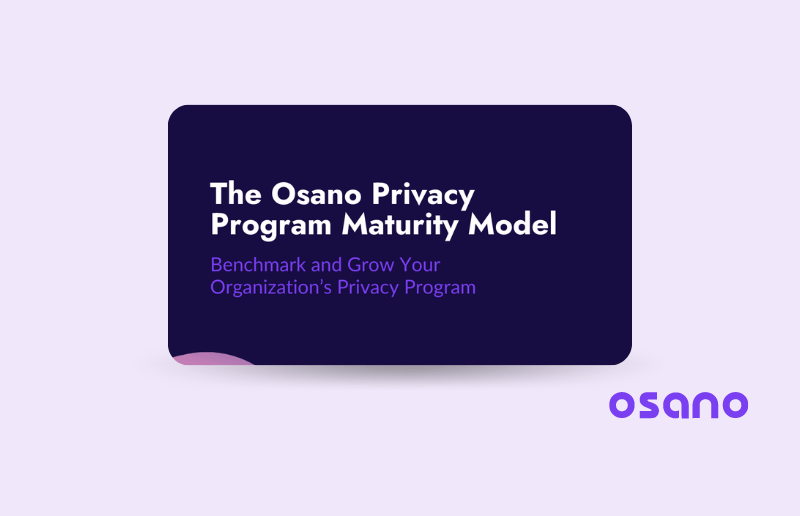A: Early and often.
It’s easy to work in a silo; working with other teams often asks more of you. But which is more advantageous?
The latter, of course. Especially when it's your organization's privacy team working with all other departments.
The old adage, “There’s no ‘I’ in team,” still echoes throughout the world’s gym classes for a reason. Working in a vacuum reduces opportunities for cross-collaboration, interdepartmental communication, and better risk management. When privacy teams are regularly talking to other departments, companies can arrive at faster solutions, organizational improvements, and greater customer trust and satisfaction.
And with the advent (and implications) of powerful tools like AI, cross-functionality with other departments is more important than ever. A privacy team cannot analyze and manage something like AI alone. It takes a village to determine how new, uncharted tools affect a company as a whole, from privacy to HR, marketing, and product. Bottom line: Whatever can be considered a privacy issue is very likely a business issue, too.
Ask Privacy Pros to Wear Many Hats—They’ll Happily Oblige
Historically, privacy teams haven’t been brought into most business initiatives and challenges until the end. Typically, this happens when teams don’t realize they need privacy’s involvement until they’re either nearing the finish line or it’s already too late.
It’s understandable. It isn't always clear that data privacy is relevant to a project at first, so it isn't brought in until the very end (if at all). But the solution is simple: Involve your privacy team early and often, even if you can’t yet tell whether it’s warranted. Not only can a privacy team bring new perspectives to the table, but they’ll also ensure that whatever the initiative, it’ll be ready for lift-off with few data privacy concerns attached.
With data being at the heart of so much of what we do online, working with teams that understand digital footprints is the key to many business initiatives, including digital transformation and workflow automation.
It's easy to place privacy a little lower on a company's list of priorities, but this is a common mistake—eventually, it ends up becoming a requirement or necessity in many initiatives anyway. Conversely, it’s also on the privacy team to make sure they’re regularly checking in with other departments to keep a pulse on activities that may involve or affect data privacy and usage.
As an example of how other teams in your company may lean on privacy, consider your inclusion and equal opportunity policy for hiring new employees. If your company is mindful about the data it collects, your HR team can better identify potential needs and gaps in talent:
- What’s the number of women in our organization?
- How many are in leadership positions?
- How many people of color exist across every company level, and where are there gaps?
- And similar questions.
The data your privacy team collects can directly answer these questions, thus leading to more intentional hires by HR.
Entering Unfamiliar Territory Means All Hands on Deck
Let’s turn our attention back to how privacy can be a relevant cross-functional partner for challenges like assessing AI and its impact on organizations. Put simply, AI’s impact is still a big question mark. Right now, most companies are doing their best to figure out how AI works for them (and how it may work against them).
Currently, much of the responsibility for assessing AI’s impact tends to fall on privacy teams. That’s understandable to a degree: AI brings unique challenges that make it harder to predict and to manage associated risk, especially as it pertains to data privacy. But leaving privacy teams to shoulder this work alone is not the strongest plan of attack. Instead, a better approach is to bring all departments together to assess the new tool as a united front, especially because AI’s implications potentially touch so many facets of an organization.
If company leaders can build awareness about new trends like AI—trickling what they learn down to their departments—then teams can identify risks sooner and proactively seek their privacy team’s guidance.
In the same vein, a company’s privacy team should recognize that whatever they’re learning about the latest privacy regulations, potential risk factors, or emerging trends should also be shared with other departments. When all teams in an organization are talking, that’s when the real alignment begins.
From your DEI hiring policy to how you handle uncharted trends, the data your company collects impacts the way you approach either circumstance. Encourage teams in your organization to connect with privacy professionals early and often to ensure you’re leveraging collected data for its fullest benefits—with accuracy, care and, everyone’s interest in mind.
For more on beginning or advancing your data privacy journey, reach out to a partner like Osano. Schedule a demo to learn more.
Privacy Program Maturity Model
Looking to level up your existing privacy program, or develop a new one? Find out what key program elements to prioritize and how to scale with the Osano Privacy Program Maturity Model!
Download Your Copy

Rachael Ormiston
Rachael Ormiston
Rachael Ormiston is the Chief Privacy and Trust Officer at Osano. With over 15 years of professional experience, she has deep domain expertise in Global Privacy, Cybersecurity, and Crisis and Incident Response. Rachael is an IAPP FIP and has previously served on the IAPP CIPM Exam Development board. She has a personal interest in privacy risk issues associated with emerging technologies.
.webp?width=1220&height=1090&name=Osano-guarantee-seal%20(1).webp)



